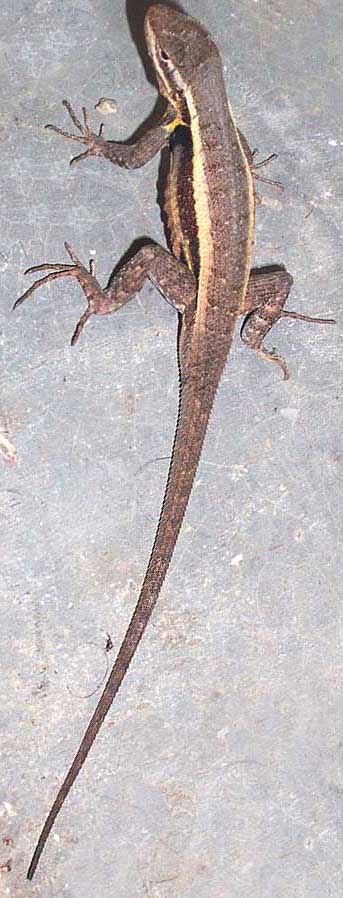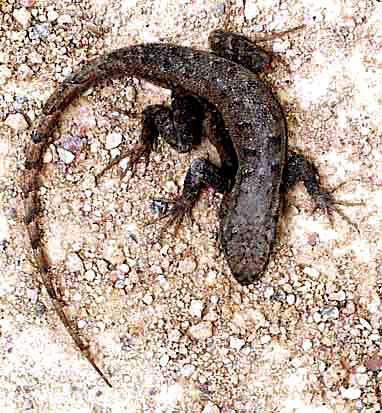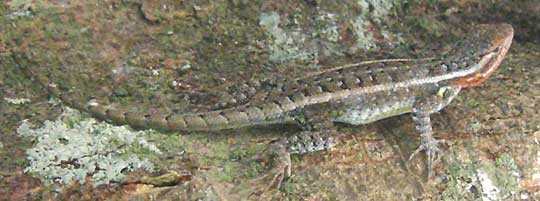Excerpts from Jim Conrad's
Naturalist Newsletter
from the May 5, 2007 Newsletter issuedissued from Sierra Gorda Biosphere Reserve, QUERÉTARO, MÉXICO
VISITED BY A ROSEBELLY LIZARD
One hot, sunny afternoon this week as I worked at the computer and cicadas made a real racket in the Sweet Acaias, I heard the pattering of tiny feet as something streaked through my open door, ran across my concrete floor and my bare feet, and tried to climb up the wall beside me to reach my window. However, a blue, plastic shopping bag lying below the window had to be surmounted, but the bag was too smooth to climb. The creature just spun his wheels noisily until he gave up and lay there in a nest of blue plastic looking up at me as if to say, "OK, I'm a lizard, and I'm in a mess... "
Now that it's much hotter and drier I'm seeing this species more often. By the time he'd recuperated from trying to climb the blue plastic bag, and begun wandering across my floor, I had my camera ready. Below, you can see the resulting picture, taken right beneath my chair.

This wasn't the first time I'd tried to photograph this species. Just a couple of days earlier I'd been walking along the reservoir when a male appeared atop a white limestone rock holding his head so high that at first I thought he was chomping on a golden-winged butterfly, with a wing bent downward at each of his mouth's corners. But then I saw that the "wings" were the lizard's belly patches. Here was a male full of hormones displaying from a spot where the whole world could admire him, especially females. When I reached for the camera, he jumped from the rock and streaked across the road.
These hot-weather lizards appear to be Rosebelly Lizards, SCELOPORUS VARIABILIS, distributed from southern Texas through eastern Mexico to Costa Rica. A website in Texas describes males as having "two pink belly patches partly rimmed in dark blue which extends onto sides of body to form dark spots in armpit and in groin." What I saw was golden, not pink, so who knows what's going on?
Why did this lizard rush into my room and try to reach my window on the other side? I learned the answer to that while my visitor still lay atop his blue, plastic bag. Another lizard of the same species, apparently having chased my visitor into the room, appeared at my door's entrance, wouldn't enter, but definitely glared in our direction. I'd guess that my first visitor was either a female trying to escape a too-persistent suitor, or a low-ranking male being driven from the other's territory. Probably the latter.
from the February 23, 2007 Newsletter issued from Sierra Gorda Biosphere Reserve, QUERÉTARO, MÉXICO
THE SPINY SWIFT IN MY ADOBE OVEN
A lizard lives in the oven. When I'm cooking he moves into one of the special ventilation chambers and doesn't seem to mind -- actually seems to like the heat. When you walk along the reservoir, every roadcut with exposed rocks entertains this kind of lizard -- sometimes five or more scampering away as you walk by. You also see them in forests, even at higher elevations. They're all over the place, and they're very similar to the North's fence, or spiny, lizards. Below, you can see the one on my adobe oven.

It's the Rosebelly Lizard again, different view
from the February 11, 2008 Newsletter issued from near Venustiano Carranza in the Central Valley of Chiapas, MÉXICO
ROSEBELLY LIZARD
Having met Rosebelly Lizards in Queretaro, I think I've run into them again here in Chiapas. You can see it parked on the trunk of a Ramón tree in a shadowy woods below:

This one is a little different from the Querétaro one, but not much, especially for someone with a species name like variabilis.
The species is abundant here. I'm parking the picture here for that eventual graduate student who might come along someday trying to clean up the mess the genus Sceloporus is in, and who might like to see some of variablilis's variations I've run into.